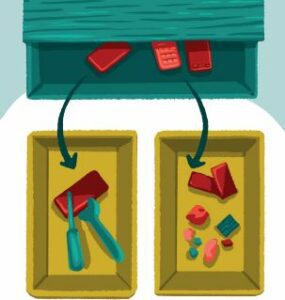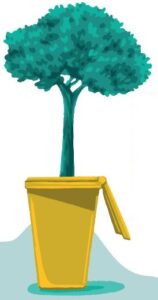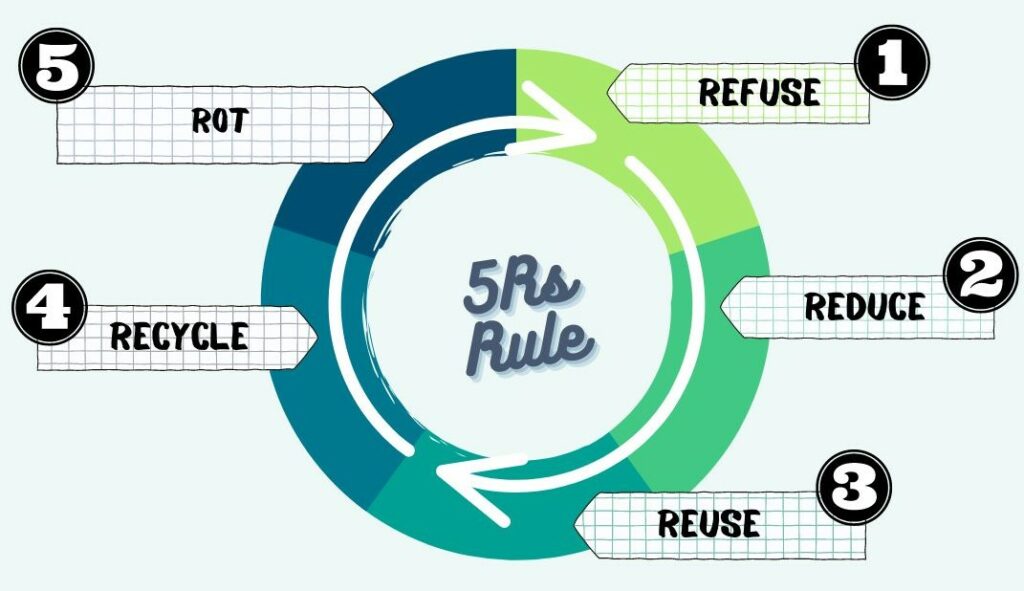The 5Rs ? The golden rule “refuse, reduce, reuse, recycle, rot” or “refuse, reduce, reuse, recycle and give back to the earth” comes from Bea Johnson’s book Zero Waste and enables us to structure an approach to reducing our waste, including plastic.
REFUSE
It is simply saying no to what we may not need, asking ourselves if the product is really useful.
A survey (available here) of 24,000 people in 24 countries showed a change in behaviours towards avoiding plastic waste. In 2021, 44% of people responded that they avoid buying products with a lot of packaging, compared to 39% of people in 2019. In France, in 2021, 47% of consumers responded that they reject “excessive” plastic packaging. Despite the limitations of the study, the evolution of the figures obtained still shows a growing awareness and motivation to refuse certain plastics.
According to the Climate & Resilience Law, since 1 July 2022, it is no longer allowed to provide a sample to a consumer as part of a commercial approach, unless the consumer himself requests it.
REDUCE
To tackle plastic waste, the best solution is to produce as little as possible. What we cannot refuse, we will try to reduce it: it requires questioning our habits, questioning our consumption way, buying less but better, making things durable…
The guide Zéro déchet, zéro gaspi of Zero Waste France suggests the BISOU method to question the acts of consumption:
B is for Besoin (Need): what need does it answer?
I for Immediat (Immédiat): can I wait a few days before deciding?
S as in Semblable (Similar): do I already have an object that has this utility?
O is for Origine (Origin): what is the origin of this product?
U is for Utile (Useful): will this object bring me a primary comfort?
If this method applies mostly to consumer decisions, we can ask similar questions for companies: What needs does the product meet? What are these reasons for being? Can we answer these needs in other ways? How can we reduce its functions to the essential?
Among the possible ways of reduction, we can try to limit the over-packaging, but also the “over-quality” of products. Indeed, while plastics have many advantages and increasingly advanced properties, we observe the development of excessive requirements. To reduce is to seek to achieve the “right packaging”; eco-responsible and with satisfying properties, but not oversized. It also means reducing the purchase of new goods, considering the use of second hand or reconditioned, or reducing the impact of transportation by buying local products.
RECYCLING
Recycling means reintegrating materials from a product at the end of its life into a new product. This allows a new life cycle to be started again, from a material that is not virgin. While there is no universal definition of recycling, we can use the European definition to refine our understanding of the subject:
“Recycling” means any recovery operation by which waste is reprocessed into products, materials or substances for its original function or for other purposes. This includes the reprocessing of organic material, but does not include energy recovery, conversion for use as fuel or for landfill operations.
[Directive 2008/98/CE]
Why recycle?
- To reduce our waste, and therefore its inherent pollution, some materials (such as plastic) take centuries to degrade.
- To preserve natural resources, as recycled material allows us to reduce the amount of material we have to extract.
- To save money and create local jobs in the area.
- To imitate nature and its closed loop system. In nature, waste does not exist and matter is constantly transformed…
Recyclable vs. Recycled: when we talk about packaging, we sometimes hear that it is recyclable, but this does not mean that it will be effectively recycled at 100%. Indeed, to be recycled, the packaging must be :
- Collected, for example by throwing it in a yellow bin
- Sorted, in a sorting centre according to its material
- Prepared, that the different elements are separated, that the material is washed and crushed
- Regenerated, the raw material is recycled and can then be re-integrated into a new product
ROT
Giving back to the Earth some of the resources we’ve taken from it is the final step in putting our waste to good use. Composting is a solution for reducing the volume of your trash cans: in your house or apartment, in the country or in the city, thanks to composters, you can recycle your vegetable waste, egg shells, coffee grounds… and biodegradable/compostable packaging…
To see more clearly on the subject, let’s go over some definitions:
Composting is a process of transformation of fermentable materials (which can enter into fermentation) in controlled conditions of temperature, pressure and/or in the presence of micro-organisms. It allows to obtain a fertilizing material, the compost. In France, standards define the compostability criteria in industrial and domestic conditions.
Biodegradable qualifies materials that can be degraded in a reasonable time by living organisms, into water, CO2, methane and possibly into non-toxic residues (e.g. biomass). Thus, the properties of biodegradability do not depend solely on the raw material of a packaging, and do not allow valorization.
Thus all biodegradable packaging is not necessarily compostable! Moreover, these transformations depend on the parameters of the environment; in case of leakage in the ocean for example, a biodegradable or compostable plastic could persist much longer than in the conditions of a laboratory or a composter. The priority remains to reduce the use of plastics at the source, and for that we refer you to the other Rs : 1st R – Refuse, 2nd R – Reduce…
REUSE
What is reuse, what is repurpose? The distinction between these two words is sometimes difficult to apprehend. This one resides in reality by the transition or not of the good by the status of waste in its end of life. Where a reused good will have been considered at one stage of its life as “used waste”, a reused product will not be considered as waste even between two cycles of use.
The following definitions of the French Environmental Code (art. L541-1-1) moreover enable this distinction:
→ Reuse :
Any operation by which substances, materials or products that are not waste are used again for a use identical to that for which they were designed.
→ Reutilization :
Any operation by which substances, materials or products that have become waste are used again.
We identify 2 different models of reuse:
Refill: the packaging belongs to the consumer and is refilled at home or at the store. The refill trends are: customization of packaging, automatic refill by subscription or customization of delivery systems (choice of quantity, choice of flavors…)
Return: the ownership of the packaging is transferred to the company when it is returned from home (collection system) or when it is brought back to the store. The seller is then responsible for washing it and making it available for the same use. Return trends include: companies sharing infrastructure, using smart tracking systems (especially to monitor deposit payout), or selling the packaging as a service to amortize logistics costs.

Beware, some materials cannot be recycled ad infinitum, and require the addition of new raw materials each time, this is for example the case of plastic. Others, although technically infinitely recyclable, consume a lot of energy to regenerate the material at each cycle, such as glass, which has to be heated in ovens to 1500°C…
Thus, the priority remains to reduce our use at source.
As far as the plastic is concerned, we invite you to go and see :
The fact sheet we produced as part of our BeMed mission
The Mr & Mrs Recycling website ♻️, a real mine of information on the subject to sort out the real from the fake.




